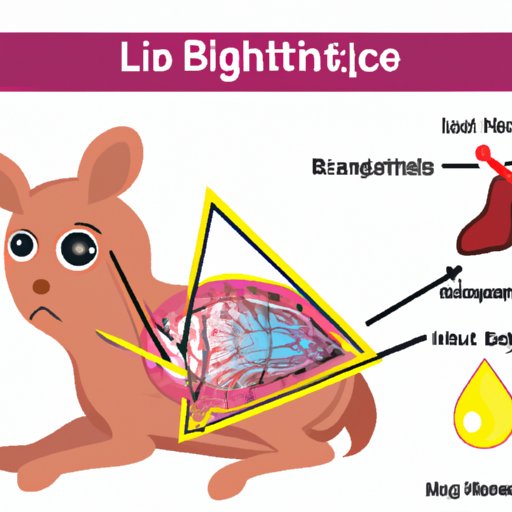
Introduction
Liver disease is a condition that affects the liver’s functionality and can lead to severe complications when left untreated. It progresses through different stages, each with its own set of symptoms and medical significance. One of these stages is the itching stage, characterized by persistent, intense itchiness throughout the body. This article will explore the itching stage of liver disease, its symptoms, and what it indicates for liver health.
Scratching the Surface: Understanding the Itching Stage of Liver Disease
The itching stage of liver disease refers to the stage when pruritus or the uncontrollable itching sensation affects most parts of the body. It can be challenging to pinpoint the cause of itching in liver disease, but it is thought to result from a buildup of bilirubin, a yellow pigment produced when the liver breaks down old red blood cells.
Bilirubin is not adequately removed from the body when the liver is not functioning correctly, accumulating under the skin and causing irritation and itchiness. This itchiness is often severe, affecting sleep and daily activities, and can be a significant factor in the patient’s quality of life. The itching stage is medically significant because it indicates a more severe condition that can lead to liver failure in the absence of treatment.
The Unbearable Itch: How Liver Disease Progresses to the Itching Stage
Liver disease progresses in different stages depending on its cause and severity. In early stages, there may be no symptoms, making diagnosing the disease more difficult. As liver disease progresses, the affected individual may notice a general feeling of malaise, fatigue, or discomfort.
The itching stage of liver disease typically occurs in the advanced stages of the disease, and it can affect patients during the liver cirrhosis and hepatitis stages. Other liver diseases that can cause itching include primary biliary cholangitis, primary sclerosing cholangitis, and obstructive jaundice, among others. Understanding the cause of itching in liver disease is essential for proper diagnosis, management, and treatment.
Don’t Scratch That Itch: Recognizing the Itching Stage of Liver Disease
Itching is not exclusive to liver disease, making it difficult to pinpoint when it is liver-related. However, individuals experiencing liver disease usually manifest other symptoms aside from itchiness, providing an indication of its severity. If you observe yellowing of the eyes or skin, abdominal swelling, abdominal pain, and diarrhea or nausea, it may be a sign of liver disease.
In identifying the itching stage, aside from severe itchiness, it is usually worse at night and in warm areas of the body, like the palms or soles. Itching is often the most noticeable and often longstanding symptom of liver disease, even after other symptoms improve or resolve.
Itching for Answers: Exploring the Symptoms of the Itching Stage in Liver Disease
Itching is not the only symptom observed in the itching stage of liver disease. Patients may experience related symptoms that can further affect their quality of life. Itching is often accompanied by fatigue, insomnia (difficulty sleeping), dark, tea-colored urine, and light-colored stools due to lack of bile production. In some cases, the buildup of bilirubin may also cause jaundice, with the skin and eyes taking on a yellow hue.
These symptoms indicate that the liver is not functioning correctly and points to the severity of the condition. Proper management and treatment are essential in this stage to avoid the risk of liver damage or failure.
The Tipping Point: How the Itching Stage Indicates Severe Liver Disease
The itching stage is a crucial indicator that liver disease is advancing and can lead to further complications when left unmanaged. Severe and persistent itching affects the patient’s quality of life, causing stress and depression, and is also a sign of liver failure. Liver failure occurs when the liver is unable to function correctly, leading to acute liver damage and potentially life-threatening complications.
To avoid worsening of the condition and further complications, patients in the itching stage require urgent medical attention. In some cases, their liver disease may require medications or medical procedures to aid liver function or prevent it from deteriorating further.
From Annoying to Alarming: Decoding the Itching Stage in Liver Disease
Itching in liver disease, especially during the advanced stages, can be challenging for patients to bear. Aside from the physical discomfort, it can affect their daily routine and limit their ability to participate in activities they used to enjoy. It can trigger depression, anxiety, or affect other aspects of their mental health, indicating the need for prompt intervention.
Treatment for the itching stage can involve proper management of the condition and medication to control the symptoms. Home remedies to manage itching, such as wearing loose clothing or taking cool baths, can also be helpful to alleviate the symptoms. Some patients may also opt for alternative therapies such as acupuncture or massage therapy to reduce itching symptoms.
The Final Warning: What Itching Means for Late-Stage Liver Disease
Late-stage liver disease is characterized by severe liver damage that cannot be treated or reversed. At this stage, patients may develop symptoms that indicate the final stages of liver failure, such as vomiting blood, severe abdominal pain, and disorientation. The itching symptom at this stage often worsens and becomes more severe and discomforting, pushing patients to seek prompt medical attention.
Conclusion
The itching stage of liver disease is an essential symptom to recognize and address promptly. It not only significantly affects the patient’s quality of life but is also an indicator of severe liver damage that can lead to liver failure. Recognizing the symptoms of liver disease and seeking prompt medical attention can help in managing the condition and prevent complications from arising. If you experience any of the symptoms mentioned above, seek medical attention and explore the available treatment options.





